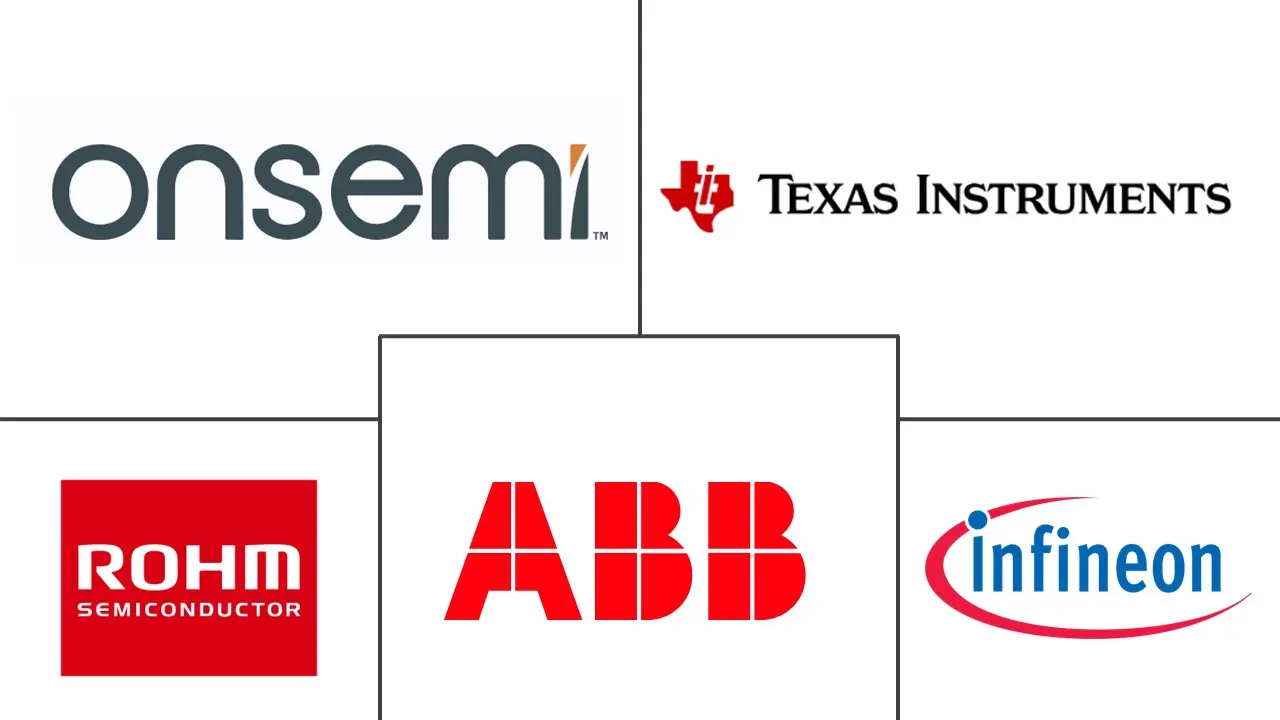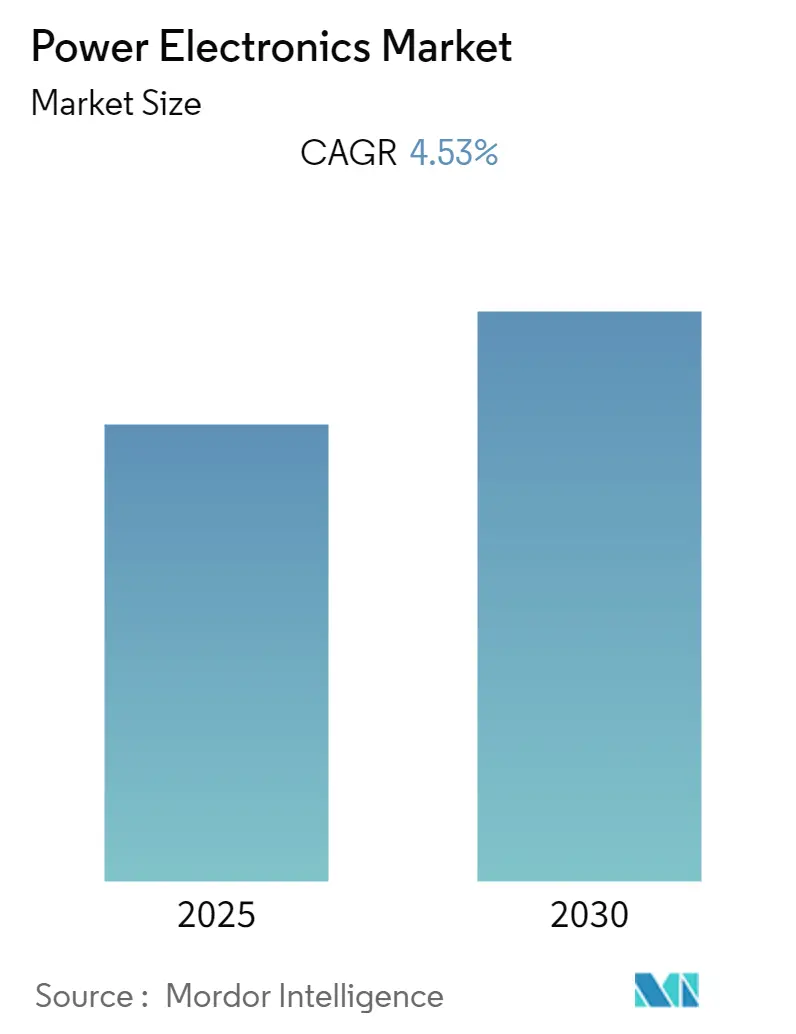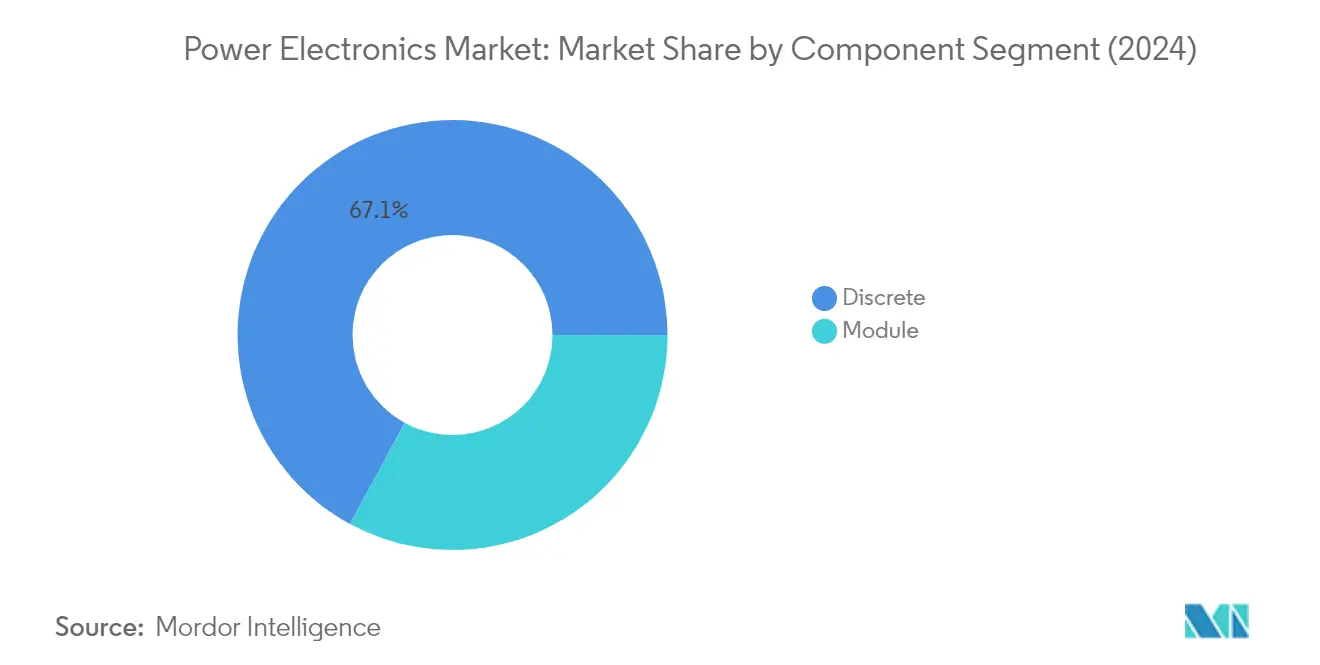Power Electronics Market Analysis
The Power Electronics Market is expected to register a CAGR of 4.53% during the forecast period.
The power electronics industry is undergoing a significant transformation driven by the increasing global focus on energy efficiency and sustainable power solutions. With electrical energy consumption reaching unprecedented levels of 25,343 terawatt-hours, the industry is witnessing a fundamental shift toward more efficient power conversion and distribution systems. Power electronics have emerged as a crucial technology for controlling electrical energy flow, with advanced solutions potentially reducing energy losses by up to 50% in voltage conversion processes. The integration of wide bandgap semiconductors, particularly silicon carbide (SiC) and gallium nitride (GaN), is revolutionizing power management capabilities across various applications, enabling higher operating temperatures and improved power density.
The industry is experiencing rapid technological advancement in semiconductor materials and device architectures. According to IRENA, global renewable generation capacity reached 3,372 gigawatts by the end of 2022, highlighting the growing importance of power electronics in renewable energy integration. Major manufacturers are investing heavily in research and development of next-generation power electronics devices, with a particular focus on improving efficiency and reducing form factors. The emergence of intelligent power modules and advanced thermal management solutions is enabling more compact and efficient power conversion systems, particularly in high-power applications.
The proliferation of connected devices and industrial automation is creating new opportunities for power electronics applications. According to Cisco's projections, the number of networked devices is expected to reach 29.3 billion by 2023, driving demand for efficient power management solutions. Industrial facilities are increasingly adopting smart manufacturing processes that require sophisticated power control systems, leading to the development of more advanced power electronics solutions. The integration of Internet of Things (IoT) capabilities with power electronics is enabling real-time monitoring and optimization of power consumption across industrial operations.
The modernization of power infrastructure and the development of smart grids are catalyzing innovations in power electronics. According to BankMyCell, with smartphone penetration reaching 86.29% of the global population in 2023 (approximately 6.92 billion users), the demand for efficient charging solutions and power management systems continues to grow. Power electronics manufacturers are developing new solutions for high-voltage direct current (HVDC) transmission systems and grid-scale energy storage applications. The industry is witnessing increased investment in research and development of advanced power electronics systems that can handle higher voltages and frequencies while maintaining optimal efficiency levels. The emerging trends in power electronics are thus pivotal to the future of energy management and infrastructure development.
Power Electronics Market Trends
Rising Demand for High-Energy and Power-Efficient Devices in the Electronics Segment
The increasing consumption of consumer electronics devices worldwide is driving significant demand for power electronics, particularly in applications requiring high energy efficiency and power management capabilities. According to BankMyCell, in 2023, the number of smartphone users worldwide has reached 6.92 billion, representing 86.29% of the world's population owning a smartphone. This massive user base, combined with the growing complexity of modern devices featuring more applications, faster processors, improved RAM/ROM, and new displays, has created an unprecedented demand for efficient power management solutions. Additionally, with Cisco predicting 29.3 billion networked devices by 2023, the need for power-efficient components has become more critical than ever.
The evolution of charging technologies and power management systems has further accelerated the demand for advanced power electronics products. Modern devices require chargers to deliver optimum power in the shortest possible time, driving innovations in technologies like GaN (Gallium Nitride) power electronics that offer increased efficiency and lower heat generation. Industrial appliances such as uninterruptible power supplies (UPS), server power supplies, power converters, and motor drives are also witnessing increased adoption of industrial and power electronics solutions due to their ability to substantially reduce operating costs through improved power density and thermal performance. This trend is particularly evident in data centers and industrial applications where power efficiency directly impacts operational expenses and system reliability.
Demand for Green Energy Power Generation Drives
The rapid increase in global energy consumption, coupled with growing environmental concerns, has significantly accelerated the shift toward greener energy sources, creating substantial demand for power electronics in renewable energy applications. Power electronics companies are becoming increasingly crucial for conversion circuits used in turbine generators that generate renewable or green energy, while also ensuring power supply stability and reduced consumption. The industry has witnessed significant technological advancements, particularly in the development of Silicon Carbide (SiC) and Gallium Nitride (GaN) based power electronics, which offer superior performance in renewable energy applications.
The automotive sector's transition to electric vehicles has emerged as a major driver for power electronics in green energy applications. For instance, China's automotive market demonstrated strong adoption of electric vehicles, with 5.67 million EVs and plug-ins sold in 2022, according to the China Passenger Car Association, driven by government subsidies and high oil prices. Power electronics play a crucial role in these vehicles, particularly in powertrain systems where components like MOSFETs and IGBTs serve as power electronic switches. The trend extends beyond automotive applications to include solar inverters, wind turbines, and other renewable energy systems where power electronics are essential for efficient energy conversion and management. This shift is further supported by various government initiatives and industry developments, such as the PowerUP Asia conference in April 2023, which highlighted the latest technological developments in power electronics focusing on power efficiency, carbon reduction, and greener energy solutions.
Segment Analysis: By Component
Discrete Segment in Power Electronics Market
The discrete power electronics market continues to dominate the global power electronics market, commanding approximately 67% market share in 2024. This significant market position is primarily driven by the widespread application of discrete power electronics devices across various industries, including automotive, consumer electronics, and renewable energy sectors. Discrete power components like MOSFETs and IGBTs play a crucial role in controlling automotive electronics, managing power in consumer devices, and optimizing energy conversion in renewable energy systems. The segment's dominance is further strengthened by the increasing demand for efficient power electronics products in smartphones, laptops, and electric vehicles, where discrete components are essential for functions such as battery protection, power conversion, and motor control. Additionally, the growing adoption of discrete power semiconductors in solar inverters and wind energy applications has contributed substantially to maintaining its leading position in the market.
Module Segment in Power Electronics Market
The module segment is experiencing the highest growth trajectory in the power electronics market, with an expected growth rate of approximately 6% during 2024-2029. This accelerated growth is primarily attributed to the increasing demand for integrated power solutions in high-power applications such as electric vehicle central inverters and industrial motor drives. Power modules are gaining significant traction due to their ability to improve power handling and reliability while decreasing parasitic circuit elements. The segment's growth is further fueled by technological advancements in intelligent power modules, which incorporate additional control and protection circuitry, making them ideal for applications requiring precise power management and enhanced safety features. The trend toward more compact and efficient power solutions, particularly in automotive and renewable energy applications, continues to drive innovation in module design and functionality.
Segment Analysis: By Material
Silicon/Germanium Segment in Power Electronics Market
The Silicon/Germanium segment continues to dominate the power electronics market, commanding approximately 90% market share in 2024. This dominance is attributed to silicon's remarkable versatility as a semiconductor material, particularly its stability and effectiveness in controlling electrical current. Silicon's inherent strength, 1.12 eV energy band gap at absolute zero, and ability to be enhanced through doping make it an ideal choice for a wide range of applications. The material's widespread adoption spans across consumer electronics, including smartphones, laptops, LED lights, and various power management systems. The combination of silicon and germanium in SiGe has enabled the integration of CMOS logic with heterojunction bipolar transistors, making it particularly suitable for mixed-signal circuits, offering superior low-current and high-frequency performance through adjustable band gap capabilities.
Gallium Nitride (GaN) Segment in Power Electronics Market
The Gallium Nitride (GaN) segment is experiencing remarkable growth, projected to expand at approximately 52% CAGR from 2024 to 2029. GaN's exceptional characteristics, including a wide bandgap of 3.5 eV and superior electron mobility, position it as a revolutionary material for high-power, high-frequency semiconductor applications. The technology enables the fabrication of semiconductor devices with low ON resistance combined with very high switching frequency capability. These attributes make GaN particularly valuable in power systems for electric vehicles, renewable energy applications, and RF power amplifiers. The material's ability to operate at temperatures above 200°C, coupled with its ideal electric switching characteristics, makes it increasingly attractive for next-generation power electronics applications, particularly in high-frequency 5G deployments and millimeter-wave bands ranging from 30 GHz to 300 GHz.
Remaining Segments in Power Electronics Market by Material
Silicon Carbide (SiC) represents a significant advancement in power electronics technology, offering a compelling middle ground between traditional silicon-based devices and cutting-edge GaN solutions. SiC's exceptional physical and electronic properties make it particularly suitable for high-power applications, especially in electric vehicle drive converters and renewable energy systems. The material's ability to operate at higher temperatures and voltages, combined with its superior thermal conductivity, positions it as a crucial component in the evolution of power electronics devices. The technology has gained significant traction in applications requiring high-temperature operation and efficient power management, particularly in automotive and industrial sectors where reliability and performance are paramount.
Segment Analysis: By End-User Industry
Consumer Electronics Segment in Power Electronics Market
The consumer electronics segment maintains its dominant position in the global power electronics market, commanding approximately 29% market share in 2024. This leadership is driven by the widespread adoption of power electronics devices in smartphones, laptops, and home appliances where discrete power semiconductors like MOSFETs and IGBTs play crucial roles. The segment's growth is further supported by the increasing integration of GaN-based transistors and ICs in consumer devices, particularly in chargers and adapters, enabling significant miniaturization and improved power efficiency. Major manufacturers are focusing on developing advanced power electronics products for consumer electronics, with particular emphasis on reducing heat dissipation, improving charging speeds, and enhancing overall device performance. The segment's strength is also reinforced by the rising global demand for smart home devices and wearable technology, which require sophisticated power management solutions.
Energy and Power Segment in Power Electronics Market
The energy and power segment is emerging as the fastest-growing sector in the power electronics market, with an expected growth rate of approximately 10% during 2024-2029. This remarkable growth is primarily driven by the increasing adoption of renewable energy sources and the ongoing modernization of power grids worldwide. The segment is witnessing substantial innovation in power semiconductor materials, particularly in SiC-based devices, which are increasingly being utilized in smart grid applications and energy meters. The transition toward sustainable energy solutions, including solar and wind power generation, is creating unprecedented demand for power electronics components that can handle high-voltage transmission and efficient power conversion. The segment's growth is further accelerated by global initiatives promoting clean energy adoption and the increasing investments in smart grid infrastructure.
Remaining Segments in End-User Industry
The industrial and power electronics market encompasses several other significant segments including industrial, automotive, IT and telecommunications, and military and aerospace sectors. The industrial segment continues to drive substantial demand through applications in uninterruptible power supplies, motor drives, and industrial automation systems. The automotive sector is experiencing transformative growth with the increasing adoption of electric vehicles and advanced charging infrastructure. The IT and telecommunications segment is being driven by the expansion of data centers and 5G infrastructure deployment. The military and aerospace segment, while smaller in market share, remains crucial for specialized applications requiring high-reliability power electronics solutions. Each of these segments contributes uniquely to the market's dynamics through specific technological requirements and innovation demands.
Power Electronics Market Geography Segment Analysis
Power Electronics Market in North America
North America represents a significant portion of the global power electronics market, accounting for approximately 18% of the global market share in 2024. The region's dominance is primarily driven by substantial investments in research and development for high-tech semiconductors and robust semiconductor manufacturing capabilities. The United States leads the regional market with its strong focus on electric vehicle adoption, renewable energy integration, and advanced power management systems. The region's growth is further supported by increasing deployment of 5G infrastructure, which demands sophisticated power electronics components. The automotive sector, particularly the electric vehicle segment, continues to be a major growth driver with various manufacturers expanding their production capabilities. Additionally, the region's strong presence in aerospace and defense applications, coupled with increasing military spending, creates sustained demand for specialized power electronic components. The emphasis on energy efficiency and sustainable power solutions across industries further reinforces the power electronics market growth trajectory in North America.
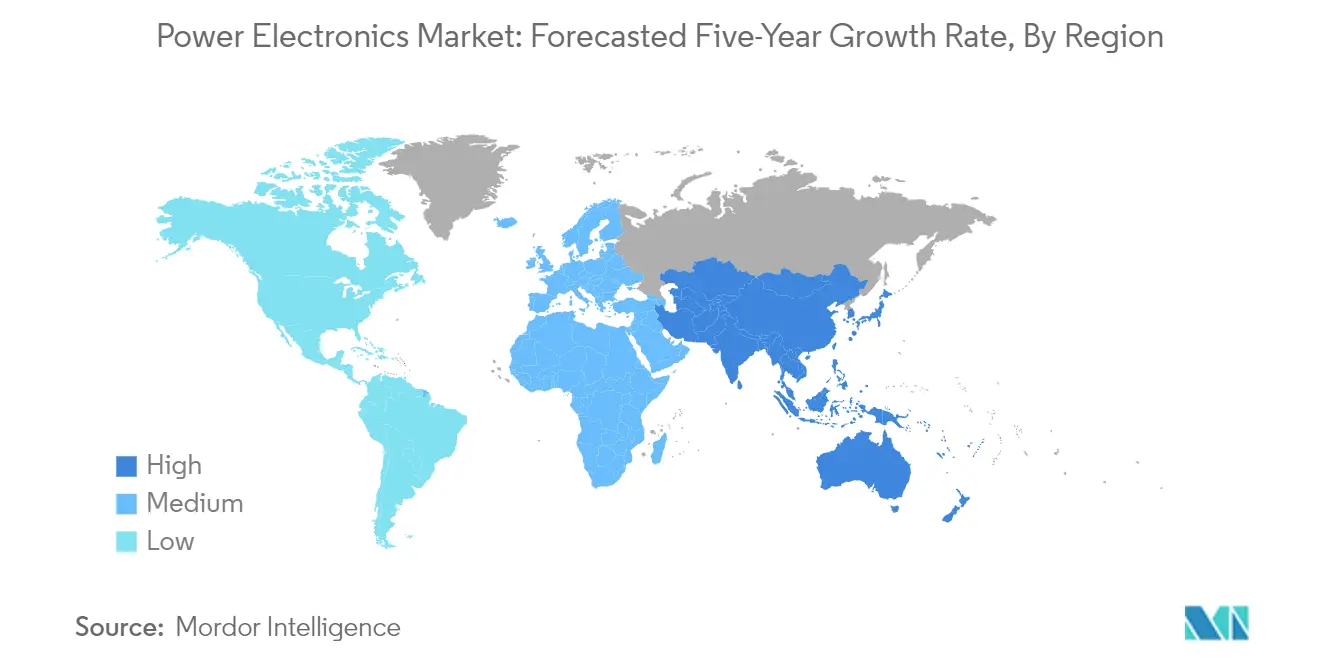
Power Electronics Market in Europe
The European power electronics market has demonstrated robust growth with an annual growth rate of approximately 4% during 2019-2024. The market's expansion is primarily driven by developments in the automotive sector, renewable energy production, and increasing investments in the telecom sector. The region's commitment to sustainable energy and electric mobility has created significant opportunities for power electronics manufacturers. Germany, being a leader in automotive innovation, continues to drive substantial demand through its focus on electric vehicle production and charging infrastructure. The region's strong industrial base, particularly in countries like Germany, France, and the United Kingdom, supports the adoption of advanced power electronic solutions in manufacturing and automation applications. European manufacturers are increasingly focusing on developing more efficient and compact power electronic components to meet the growing demand for sustainable energy solutions. The region's stringent environmental regulations and commitment to reducing carbon emissions continue to drive innovations in power electronics technology.
Power Electronics Market in Asia-Pacific
The Asia-Pacific region maintains its position as the largest power electronics market, with projections indicating a robust growth rate of approximately 5% during 2024-2029. The region's market is characterized by its strong manufacturing base, particularly in countries like China, Japan, South Korea, and Taiwan, which collectively form a crucial hub for semiconductor production. The rapid industrialization and urbanization across developing economies continue to drive demand for power electronic components. China's dominant position in electric vehicle production and adoption creates substantial opportunities for power electronics companies. The region's leadership in consumer electronics manufacturing, coupled with increasing investments in 5G infrastructure and renewable energy projects, further strengthens market growth. Japan's technological advancement in power electronics, particularly in industrial applications, contributes significantly to regional market development. The presence of major semiconductor manufacturers and ongoing technological innovations in countries like South Korea and Taiwan further reinforces the region's market leadership.
Power Electronics Market in Latin America
The Latin American power electronics market demonstrates growing potential, driven by increasing investments in renewable energy infrastructure and automotive manufacturing. The region's focus on developing semiconductor capabilities and expanding the use of power electronic devices across various industries creates new opportunities for market growth. Brazil and Mexico lead the regional market with their expanding automotive sectors and increasing adoption of electric vehicles. The region's commitment to renewable energy development, particularly in countries like Chile and Argentina, drives demand for power electronics in solar and wind power applications. The growing telecommunications infrastructure and increasing industrial automation across the region further contribute to market expansion. Latin American countries' efforts to modernize their power infrastructure and increase energy efficiency create sustained demand for power electronic components. The region's developing manufacturing sector and increasing focus on technological advancement continue to shape the market landscape.
Power Electronics Market in Middle East & Africa
The Middle East & African power electronics market is experiencing steady growth, driven by increasing investments in renewable energy projects and infrastructure development. The Gulf region's focus on solar power adoption creates significant opportunities for power electronics manufacturers. Saudi Arabia's clean energy initiatives and the UAE's investments in renewable energy projects are reshaping the regional market landscape. The region's growing focus on industrial automation and smart city development drives demand for advanced power electronic solutions. African nations' increasing focus on renewable energy adoption and electric vehicle infrastructure development contributes to market growth. The ongoing investments in 5G infrastructure deployment across the region create additional opportunities for power electronics applications. The region's efforts to diversify its economy beyond traditional oil and gas sectors, particularly in the Gulf countries, continue to drive innovations in power electronics technology. The growing focus on semiconductor manufacturing capabilities in the Middle East further strengthens the regional market's development potential.
Power Electronics Industry Overview
Top Companies in Power Electronics Market
The power electronics market is led by major players including Infineon, Onsemi, STMicroelectronics, Mitsubishi Electric, and other prominent manufacturers who have established a strong global presence through decades of operation. These leading power electronics companies worldwide are driving innovation through significant investments in research and development of advanced semiconductor technologies, particularly in silicon carbide (SiC) and gallium nitride (GaN) based products. The industry demonstrates high operational agility with companies rapidly expanding manufacturing capabilities through new facility construction and strategic capacity enhancement projects. Market leaders are actively pursuing vertical integration strategies to strengthen their supply chain control while simultaneously expanding their product portfolios through strategic acquisitions and partnerships. Geographic expansion remains a key focus area with companies establishing new manufacturing facilities and research centers across regions to better serve local markets and reduce dependency on specific regions.
Consolidated Market with Strong Regional Players
The power electronics market exhibits a moderately consolidated structure with global conglomerates holding significant market share in power electronics while regional specialists maintain strong positions in specific product categories or geographical markets. The industry landscape is characterized by the presence of diversified electronics brands who leverage their broad technological capabilities and established distribution networks to maintain market leadership, alongside specialized power semiconductor companies focusing on specific applications or technologies. The market has witnessed increased consolidation through strategic mergers and acquisitions, particularly aimed at expanding technological capabilities and gaining access to new market segments.
The competitive dynamics are shaped by a mix of large-scale integrated device manufacturers and specialized foundries, with Japanese and European companies traditionally maintaining strong positions in the automotive and industrial segments. Market consolidation continues to accelerate as companies seek to achieve economies of scale and enhance their technological capabilities through strategic acquisitions. The industry has seen several notable mergers and partnerships, particularly focused on emerging technologies like wide bandgap semiconductors, indicating a trend toward increased market concentration.
Innovation and Adaptability Drive Market Success
Success in the power electronics market increasingly depends on companies' ability to innovate in advanced semiconductor technologies while maintaining cost competitiveness and supply chain resilience. Incumbent players are focusing on expanding their product portfolios in high-growth segments like electric vehicles and renewable energy, while simultaneously strengthening their manufacturing capabilities and distribution networks. The industry's future competitive landscape will be shaped by companies' ability to address growing end-user demands for higher efficiency, smaller form factors, and improved thermal performance, while managing the challenges of high customer concentration in certain segments.
Market contenders can gain ground by focusing on specialized applications or regional markets while investing in emerging technologies and developing strong partnerships with key customers and suppliers. The relatively high substitution risk from emerging technologies necessitates continuous innovation and product development efforts. Companies must also navigate evolving regulatory requirements, particularly regarding energy efficiency and environmental standards, while maintaining competitive pricing and reliable supply chains. Success will increasingly depend on the ability to provide comprehensive solutions that address specific application requirements while maintaining flexibility to adapt to changing market conditions.
Power Electronics Market Leaders
-
ON Semiconductor Corporation
-
ABB Ltd.
-
Infineon Technologies AG
-
Texas instruments Inc.
-
ROHM Co. Ltd
- *Disclaimer: Major Players sorted in no particular order
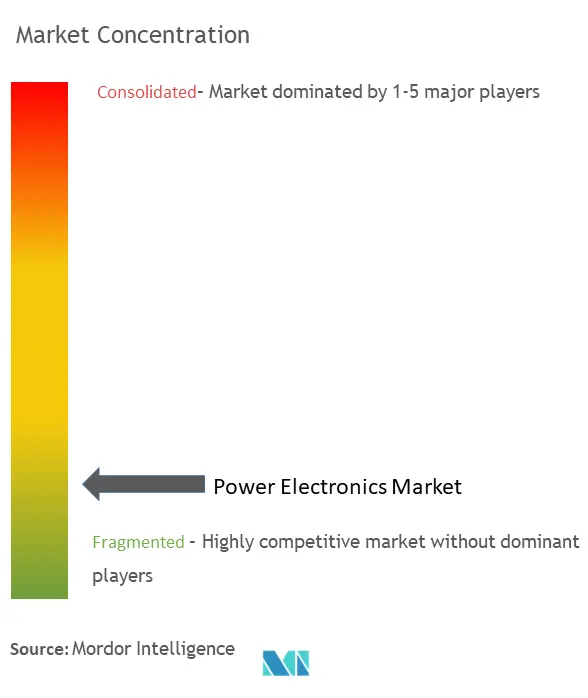
Power Electronics Market News
- May 2023: Infineon Technologies AG has launched its latest generation of power MOSFETs for automotive applications, the OptiMOS 740 V MOSFET family, in a variety of lead-free and rugged performance packages. The new family combines 300 mm thin wafer technology with innovative packaging to offer significant performance benefits in a small package. This makes this MOSFET ideal for all standard and future 40 V automotive MOSFET applications, such as braking systems, electric power steering, circuit breakers, and new zone architectures.
- May 2023: Vishay Intertechnology, Inc. has introduced 17 new third-generation 650 V silicon carbide Schottky diodes (SiC). Vishay Semiconductors' devices feature a merged pin Schottky (MPS) design that combines high surge current capability with low forward voltage drop, capacitive charging, and reverse leakage current to improve reliability and efficiency in switching power supply designs.
- May 2023: Toshiba Electronics Europe launched a new 150V N-channel power MOSFET based upon their latest generation U-MOS X-H Trench process. The TPH9R00CQ5 has explicitly been designed for high-performance switching power supplies, such as communication base stations and other industrial applications.
Power Electronics Market Report - Table of Contents
1. INTRODUCTION
- 1.1 Study Assumptions and Market Definition
- 1.2 Scope of the Study
2. RESEARCH METHODOLOGY
3. EXECUTIVE SUMMARY
4. MARKET INSIGHTS
- 4.1 Market Overview
-
4.2 Industry Attractiveness - Porter's Five Forces Analysis
- 4.2.1 Bargaining Power of Suppliers
- 4.2.2 Bargaining Power of Buyers
- 4.2.3 Threat of New Entrants
- 4.2.4 Threat of Substitutes
- 4.2.5 Intensity of Competitive Rivalry
- 4.3 Assessment of COVID -19 impact on the Industry
-
4.4 Technology Snapshot
- 4.4.1 Power Generation and Storage
- 4.4.2 Sensing and Measurement
- 4.4.3 Power Management and Distribution
- 4.4.4 Other Functions
5. MARKET DYNAMICS
-
5.1 Market Drivers
- 5.1.1 Rising Demand for High-energy and Power-efficient Devices in the Electronics Segment
- 5.1.2 Demand for Green Energy Power Generation Drives
-
5.2 Market Restraints
- 5.2.1 Rising Demand for Integrated Circuits
6. MARKET SEGMENTATION
-
6.1 By Component
- 6.1.1 Discrete
- 6.1.2 Module
-
6.2 By Material
- 6.2.1 Silicon/Germanium
- 6.2.2 Silicon Carbide (SiC)
- 6.2.3 Gallium Nitride (GaN)
-
6.3 By End-user Industry
- 6.3.1 Automotive
- 6.3.2 Consumer Electronics
- 6.3.3 IT and Telecommunication
- 6.3.4 Military and Aerospace
- 6.3.5 Industrial
- 6.3.6 Energy and Power
- 6.3.7 Other End-user Industries
-
6.4 By Geography
- 6.4.1 North America
- 6.4.2 Europe
- 6.4.3 Asia-Pacific
- 6.4.4 Latin America
- 6.4.5 Middle East and Africa
7. COMPETITIVE LANDSCAPE
-
7.1 Company Profiles
- 7.1.1 ON Semiconductor Corporation
- 7.1.2 ABB Ltd.
- 7.1.3 Infineon Technologies AG
- 7.1.4 Texas instruments Inc.
- 7.1.5 ROHM Co. Ltd
- 7.1.6 STMicroelectronics NV
- 7.1.7 Renesas electronic corporation
- 7.1.8 Vishay Intertechnologies Inc.
- 7.1.9 Toshiba Corporation
- 7.1.10 Mitsubishi Electric Corporation
- *List Not Exhaustive
8. VENDORS MARKET SHARE ANALYSIS
9. INVESTMENT ANALYSIS
10. FUTURE OF THE MARKET
Power Electronics Industry Segmentation
Power electronics include components such as capacitors, inductors, and other semiconductor devices used in the power management of various systems. Moreover, power electronics integrate energy, control systems, and electronic devices.
The study includes two types of components and materials for various end-user industries. The competitive landscape has been considered to calculate the power electronics penetration and the involvement of the key players in organic and inorganic growth strategies. These companies continuously innovate their products to increase their market share and profitability. Further, the market study also focused on the impact of the COVID-19 pandemic on the market ecosystem.
The power electronics market is segmented by component (discrete and modules), by material (silicon/germanium, silicon carbide (sic), and gallium nitride (gan)), by end-user industry (automotive, consumer electronics, IT and telecommunication, military & aerospace, industrial, energy and power, and other end-user industries), and geography (North America, Europe, Asia Pacific, Latin America, and Middle East and Africa). The market size and forecasts are provided in terms of value (USD) for all the above segments.
| By Component | Discrete |
| Module | |
| By Material | Silicon/Germanium |
| Silicon Carbide (SiC) | |
| Gallium Nitride (GaN) | |
| By End-user Industry | Automotive |
| Consumer Electronics | |
| IT and Telecommunication | |
| Military and Aerospace | |
| Industrial | |
| Energy and Power | |
| Other End-user Industries | |
| By Geography | North America |
| Europe | |
| Asia-Pacific | |
| Latin America | |
| Middle East and Africa |
Power Electronics Market Research FAQs
What is the current Power Electronics Market size?
The Power Electronics Market is projected to register a CAGR of 4.53% during the forecast period (2025-2030)
Who are the key players in Power Electronics Market?
ON Semiconductor Corporation, ABB Ltd., Infineon Technologies AG, Texas instruments Inc. and ROHM Co. Ltd are the major companies operating in the Power Electronics Market.
Which is the fastest growing region in Power Electronics Market?
Asia Pacific is estimated to grow at the highest CAGR over the forecast period (2025-2030).
Which region has the biggest share in Power Electronics Market?
In 2025, the Asia Pacific accounts for the largest market share in Power Electronics Market.
What years does this Power Electronics Market cover?
The report covers the Power Electronics Market historical market size for years: 2019, 2020, 2021, 2022, 2023 and 2024. The report also forecasts the Power Electronics Market size for years: 2025, 2026, 2027, 2028, 2029 and 2030.
Our Best Selling Reports
Power Electronics Market Research
Mordor Intelligence provides a comprehensive analysis of the power electronics market. We leverage our extensive experience in tracking electronics industry growth and market dynamics. Our detailed research covers the entire spectrum of industrial and power electronics. This includes leading electronics brands and emerging power electronics manufacturers. The report offers an in-depth analysis of power electronics devices and products. It pays particular attention to the rapidly evolving landscape of power electronics companies in India and other key regions. Available as an easy-to-download report PDF, our analysis offers detailed insights into market size and growth trajectories.
The report is an essential tool for stakeholders across the industrial electronics market. It provides valuable insights into market size and market value projections. Our analysis covers the world's top power electronics companies and examines crucial trends in energy electronic manufacturing. Stakeholders benefit from our detailed examination of power electronics market growth drivers, challenges, and opportunities. This is supported by comprehensive data on global power electronics companies and their strategic initiatives. The report delivers actionable intelligence for decision-makers, investors, and industry participants seeking to navigate the dynamic power electronics landscape.

